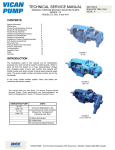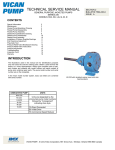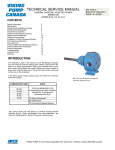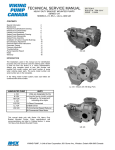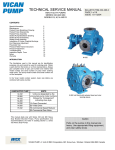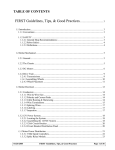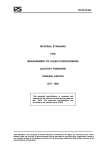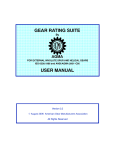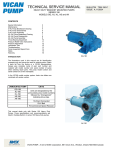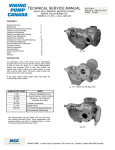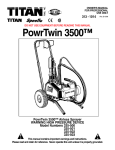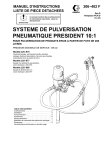Download TECHNICAL SERVICE MANUAL
Transcript
TECHNICAL SERVICE MANUAL GENERAL PURPOSE BRACKET MOUNTED PUMPS SERIES 115 MODELS H and HX4 SECTION 2 BULLETIN TSM-115-V ISSUE B. 4/03/2009 CONTENTS Special Information Maintenance Packed Pump Breakdown Drawing Packed Pump Disassembly Packed Pump Assembly Sealed Pump Breakdown Drawing Sealed Pump Disassembly Sealed Pump Assembly Installation of Carbon Graphite Bushings End Clearance Adjustment Pneumatic Test Pressure Relief Valve Instructions Pressure Adjustment Troubleshooting Inspection Form Notes Warranty 2 2 4 5 6 7 8 8 9 10 10 11 11 12 13 14 15 H-115, HX4-115 INTRODUCTION The illustrations used in this manual are for identification purposes only and cannot be used for ordering parts. Obtain a parts list from the factory or a Viking representative. Always give complete name of part, part number and material with model number and serial number of pump when ordering repair parts. The pump model number and serial number are on the nameplate. In the Viking model number system, basic size letters are combined with series number. This manual deals only with Series 115 General Purpose Bracket Mounted Pumps. Pump specifications and recommendations are listed in Catalog Section 2, Series 115 General Purpose Pumps. UNMOUNTED PUMP H-115 HX4-115 UNITS Units are designated by the unmounted pump model numbers followed by “Arrangement” indicating drive style. 13-Direct Connected 53-V-Belt Drive 70-Commercial Speed Reducer VIKING PUMP, P.O Box 398, 661 Grove Ave., Windsor, Ontario N9A 6M3 Canada DANGER BEFORE OPENING ANY VIKING PUMP LIQUID CHAMBER (PUMPING CHAMBER, RESERVOIR, RELIEF VALVE ADJUSTING CAP FITTING ETC.) BE SURE: 1. THAT ANY PRESSURE IN CHAMBER HAS BEEN COMPLETELY VENTED THROUGH SUCTION OR DISCHARGE LINES OR OTHER APPROPRIATE OPENINGS OR CONNECTIONS. 2. THAT THE DRIVING MEANS (MOTOR, TURBINE, ENGINE, ETC.) HAS BEEN “LOCKED OUT” OR MADE NONOPERATIONAL SO THAT IT CANNOT BE STARTED WHILE WORK IS BEING DONE ON PUMP. 3. THAT YOU KNOW WHAT LIQUID THE PUMP HAS BEEN HANDLING AND THE PRECAUTIONS NECESSARY TO SAFELY HANDLE THE LIQUID. OBTAIN A MATERIAL SAFETY DATA SHEET (MSDS) FOR THE LIQUID TO BE SURE THESE PRECAUTIONS ARE UNDERSTOOD. FAILURE TO FOLLOW ABOVE LISTED PRECAUTIONARY MEASURES MAY RESULT IN SERIOUS INJURY OR DEATH. ROTATION: Viking pumps operate equally well in a clockwise or counterclockwise rotation. The shaft rotation determines which port is suction and which is discharge. Port in area where pumping elements (gear teeth) come out of mesh is suction port. PRESSURE RELIEF VALVES: 1. Viking pumps are positive displacement pumps and must be provided with some sort of pressure protection. This may be a relief valve mounted directly on the pump, an inline pressure relief valve, a torque limiting device or a rupture disk. 2. There are relief valve options available on those pump models designed to accept a relief valve. Options may include a return to tank relief valve and a jacketed relief valve. Pumps equipped with a jacketed head are not available with a relief valve. 3. If pump rotation is reversed during operation, pressure protection must be provided on both sides of pump. 4. Relief valve bonnet must always point towards suction side of pump. If pump rotation is reversed, remove pressure relief valve and turn end for end. Figures 2 and 3 show 2 possible configurations, both have side suction and top discharge. A right-hand pump turns in the opposite direction to the left-hand pump. 5. Pressure relief valves cannot be used to control pump flow or regulate discharge pressure. Figure 1, Head orientation SPECIAL INFORMATION SPECIAL MECHANICAL SEALS can be installed either next to rotor hub or behind the bracket bushing. Extra care must be taken in repair of pumps with mechanical seals. Read and follow all special information supplied with pump. MAINTENANCE Series 115 pumps are designed for long, trouble-free service life under a wide variety of application conditions with a minimum of maintenance. The points listed below will help provide long service life. LUBRICATION: External lubrication must be applied slowly with a handgun to all lubrication fittings every 500 hours of operation with multi-purpose grease. Do not over-grease. Applications involving very high or low temperatures will require other types of lubrication. Consult factory with specific lubrication questions. Figure 2, Right Hand Pump PACKING ADJUSTMENT: New packed pumps require initial packing adjustment to control leakage as packing “runs in”. The adjustment should be made while the pump is operating with normal operating pressure on the discharge of the pump. Make adjustments carefully and do not over-tighten packing gland. Evenly tighten the gland fasteners until the leak is reduced to a very slow drip. If over tightened the packing will over heat, score the shaft and reduce life. After initial adjustment, inspect periodically for increased leakage and re-adjust. Once the gland has been tightened to the stuffing box, loosen the packing gland and add one ring to the stuffing box, then adjust again. Refer to instructions under disassembly, page 5, and Assembly, page 6, regarding repacking pump. CLEANING PUMP: Keep pump as clean as possible. This will facilitate inspection, adjustment and repair work and help prevent overlooking a dirt covered grease fitting. STORAGE: If pump is to be stored, or not used for six months or more, pump must be drained and a light coat of lubricant and rust preventative suitable to the application must be applied to all 2 Figure 3, Left Hand Pump internal pump parts. Lubricate fittings and apply a rust preventative to the shaft. Viking suggests rotating pump shaft by hand, one complete revolution every 30 days to circulate the oil. SUGGESTED REPAIR TOOLS: The following tools must be available to properly repair Series 115 pumps. These tools are in addition to standard mechanics’ tools such as openend wrenches, pliers, screwdrivers, etc. Most of the items can be obtained from an industrial supply house. 1. Soft Headed hammer 2. Allen wrenches (some mechanical seals and set collars) 3. Packing hooks, flexible (packed pumps) Small for 0.25 inch and 0.31 inch cross section packing 4. Arbor press Strainers: Use a strainer on the suction side of the pump to prevent foreign material from entering the pump. This can cause damage to the gears, and casing or lock-up the pump. Keep the strainer on the suction side of the pump clean and free of debris. A blocked strainer will not allow sufficient liquid to reach the pump. The lack of liquid reaching the pump will create cavitation. Cavitation is when the liquid vaporizes on its way to the pump, then returns to a liquid form on the surfaces of the pump. This is very noisy, damaging to a pump, and seriously affects the output. Figure 4, Idler bushing press fit Figure 5, Pressing the idler pin Figure 6, Casing bushing orientation 3 PACKED PUMPS Exploded View for Packed Models: H-115 and HX4-115 ITEM 1 2 3 4 5 6 7 8 NAME OF PART Bearing retainer bolts Bearing retainer Ball bearing Bracket bolts Grease fitting Bracket Packing gland fasteners Packing Gland ITEM 9 10 11 12 13 14 15 16 NAME OF PART Packing rings Casing bushing Casing Casing and bushing ass’y Grease fitting Rotor and shaft ass’y Idler Idler bushing Packed cross section 4 ITEM 17 18 19 20 21 22 NAME OF PART Idler and bushing ass’y Head gasket Idler pin Head Head and idler pin ass’y Head Bolts DISASSEMBLY OF PACKED PUMPS 1. Loosen the setscrews in the ball bearing inner race. 2. Remove the grease fitting from the casing. 3. Remove the Bracket fasteners from the casing. 4. Pull the casing with all components out of the bracket and bearing. 5. Remove the bearing retainer, and pull the ball bearing out of the bracket. 6. Mark head and casing before disassembly to insure proper re-assembly. The idler pin, which is offset in pump head, must be positioned toward and centered between the port connections to allow for proper flow of liquid through pump. Figure 1, page 2. Figure 7, Alternate the packing cuts Remove head from pump. Do not allow idler to fall from idler pin. Tilt top of head back and down when removing to prevent this. The idler and bushing should stay on the idler pin. If pump is furnished with pressure relief valve, it need not be removed from head or disassembled at this point. Refer to Pressure Relief Valve Instructions, page 11. The gaskets must be totally removed. Use new gasket when assembling pump. 7. Remove idler and bushing assembly from the idler pin. 8. Remove the packing gland fastener, and pull the gland out of the stuffing box, and off of the shaft. 9. Tap the shaft forward with a softheaded hammer, and pull it out of the casing and bushing assembly. 10. The packing may be removed with a packing puller. In some cases two pullers will be required, or pushed out with a chisel and a hammer from the bushing side (be careful not to damage the bushing). If removal, still cannot be done with the pullers, or chisel, stand the casing on the bracket mounting surface and press the bushing out through the packing area. This will remove all of the packing with the bushing. 11. Clean all parts thoroughly and examine for wear and damage. Check all parts for nicks, burrs, excessive wear and replace if necessary. 12. Check the bearings for roughness. Roughness can be determined by turning the inner and outer race opposite directions by hand. Note if the motion is smooth and free or rough and stiff. Smooth and free is desired. Figure 8, Pushing in the packing rings 13. The casing bushing can also be inspected while still in the casing. If replacement is necessary, and not already removed in step 9, stand the unit on the head-mounting surface and push the bushing out with a round bar through the packing end of the casing. Figure 9, Gland & shaft installed 5 ASSEMBLY OF PACKED PUMPS Viking supplies pumps with a wide variety of bushing materials. These materials should not all be treated the same. See “Bushing Materials” page 9. 1. Press the idler bushing into the idler gear, figure 4, page 3. Refer to Installation of Carbon Graphite Bushing see page 9. 2. Using the idler bushing as a guide, press the idler pin into the head with the tapped hole in and the groove pointing toward the center of the crescent. Figure 5, page 3 3. Coat idler pin with non-detergent SAE 30 weight oil and place idler and bushing on idler pin in the head. If replacing with carbon graphite bushing, refer to Installation of Carbon Graphite Bushings, page 9. 4. Install the casing bushing. If the bushing has a lubrication groove, install bushing with the lubrication hole aligned with the grease-fitting hole on the casing. Figure 6, page3. If carbon graphite, refer to Installation of Carbon Graphite Bushings, page 9. 5. Use only new packing suitable for the liquid being pumped. Install the packing, staggering the joints from one side of shaft to other, Figure 7, page 5. If needed, lubricate packing rings with oil, grease or graphite to aid assembly. A length of pipe will help to seat each packing ring, Figure 8, page 5. 6. Install packing gland, cap screws and nuts. Make sure the gland is installed square and nuts are loose. Figure 9. Refer to “Packing Adjustment” page 2 after the pump is assembled and installed. 7. Coat the shaft of the rotor and shaft assembly with non-detergent SAE 30 weight oil. Start the end of shaft in the casing bushing while turning counter clockwise, slowly push the shaft through the packing. Continue until the rotor and shaft assembly cannot move any further. 8. Install the head and idler assembly on pump with two casing gaskets between them. Figure 10. If the pump head and casing were marked before disassembly simply match up the markings. If not, be sure the idler pin, which is offset in pump head, is positioned between the ports. Tighten head cap screws evenly. Figure 1, page 2 shows the appropriate orientation to the ports. 9. Install the bearing into the bracket. 10. Replace the bearing retainer onto the bracket with the small step away from the bearing, figure 15, page 10. 11. Install the pump and components into the bracket and bearing assembly, figure 16, page 9. 12. Replace the grease fittings, and pipe plugs. 13. Adjust pump end clearance. Refer to End Clearance Adjustment, page 11. 14. Lubricate all grease fittings with multi-purpose grease. 6 Figure 10, Mounting the head MECHANICAL SEAL PUMPS Exploded View for Mechanical Seal Models: H-115 and HX4-115 ITEM 1 2 3 4 5 6 7 8 9 NAME OF PART Bearing retainer bolts Bearing retainer Ball bearing Bracket bolts Grease fitting Bracket Seal seat retainer fasteners Seal seat retainer Retainer o-ring ITEM 10 11 12 13 14 15 16 17 18 Mechanical Seal Cross Section Rotor Casing Bushing NAME OF PART Mechanical seal ass’y Driving Ring Casing bushing Casing Casing and bushing ass’y Pipe plug Grease fitting Rotor and shaft ass’y Idler Pipe Plug ITEM 19 20 21 22 23 24 25 NAME OF PART Idler bushing Idler and bushing ass’y Head gasket Idler pin Head Head and idler pin ass’y Head Bolts Spring Driving Ring Rotating Seat 7 Seal Seat Retainer Stationary Seat DISSASSEMBLY OF SEALED PUMPS Repeat steps 1 through 7 under “DISASSEMBLY OF PACKED PUMP”. Page 5 1. Remove the fasteners from the seal seat retainer and pull it away from the seal chamber to free the spring on the seal and remove it from the shaft. 2. Remove the pipe plug from the casing in the side of the seal chamber and loosen the 2 setscrews on the driving ring through the tapped hole in the side of the seal chamber. Figure 13 3. Remove the rotary member of seal and the driving ring from the bracket. The stationary seal seat can be gently pried out of the retainer with a small flat screwdriver. Figure 11, Installing the Seal 4. Tap the shaft forward and remove the rotor and shaft assembly from the casing and bushing assembly. 5. The bracket bushing can also be inspected while still in the casing. If replacement is necessary, stand the unit on the head-mounting surface and push the bushing out with a round bar through the packing end of the casing. 6. Clean all parts thoroughly and examine for wear or damage. Check all parts for nicks, burrs, excessive wear and replace if necessary. 7. Check the bearings for roughness. Roughness can be determined by turning the inner and outer race opposite directions by hand. Note if the motion is smooth and free or rough and stiff. Smooth and free is desired. ASSEMBLY OF SEALED PUMPS The seal used in this pump is simple to install and good performance will result if care is taken during installation. A mechanical seal keeps liquid inside the pump by having to polished faces that contact. One face is sealed to the shaft with an elastomer and rotates with the shaft. The other face is sealed to the casing, which is stationary. These faces are lapped to a high finish and their sealing effectiveness depends on complete contact. Figure 12, Installing the rotating seal components A number of heavy-duty pumps with special mechanical seals are supplied. These special seals are not discussed in TSM 115. Information is available by contacting the factory. When requesting special seal information, be sure to give pump model number and serial number. Also a wide variety of bushing materials are used. These materials should not all be treated the same. See “Bushing Materials” page 9. 1. Repeat steps 1 through 4 of “Packed Pump Assembly” Page 6. 2. Press the stationary seat into the seal seat retainer while protecting the face as pictured in figure 11. 3. Clean the casing, seal housing bore and the shaft. Make sure both are free from dirt and grit. Coat the inner diameter of the seal housing bore, and the shaft with a lubricant as recommended by your seal supplier. 4. Put the shaft through the casing bushing and rotor all the way into the casing. 5. Install the head and idler assembly on pump with two casing gaskets between them. Figure 10, page 6. If the pump head and casing were marked before disassembly simply match up the markings. If not, be sure the idler pin, which is offset in pump head, is positioned between the ports. Tighten head cap screws evenly. Figure 1, page 2 shows the appropriate orientation to the ports. 6. Place the spring on driving ring and with the setscrews already started in the threads of the driving ring. Put the spring and ring on the shaft. 7. Slide rotary member, lapped contact surface facing away from spring, onto shaft until it is in the spring. Figure 12, page 8. 8 Figure 13, Setting the driving ring 8. Push the spring and driving ring into the stuffing box so that the driving ring is visible through the access hole in the side of the seal chamber. Rotate the shaft until the setscrews are accessible, and tighten down the two setscrews on the ring, figure 13, page 8. 9. Place the seal seat retainer with the stationary seat facing the seal chamber on the shaft. 10. Check that the retainer is centered and square with the shaft. 11. Tighten the fasteners evenly and in small increments, figure 14. 12. Replace the pipe plug in the hole, in the side of the seal chamber. 13. Continue with step 8 of the "Packed Pump Assembly" INSTALLATION OF CARBON GRAPHITE BUSHINGS Figure 14, Retainer installed When installing carbon graphite bushings, extreme care must be taken to prevent breaking. Carbon graphite is a brittle material and easily cracked. If cracked, the bushing will quickly disintegrate. Use soapy water as a lubricant and adding a chamfer on the bushing and the mating part will help in installation. The additional precautions listed below must be followed for proper installation: 1. A press must be used for installation. 2. Lubricate the bushing and bore with soapy water. 3. Be certain bushing is started straight. 4. Do not stop pressing operation until bushing is in proper position. Starting and stopping will result in a cracked bushing. 5. Check bushing for cracks after installation. BUSHING Materials Viking bushing material recommendations. Material Appearance Bronze Carbon Iron Nitralloy Tungsten Yellowish Black Steel Steel Steel Installation Lubricant Not required Soapy Water Oil or anti-seize Oil or anti-seize Oil or anti-seize Figure 15, Ball bearing, retainer and bracket Operating Lubrication Required Not required Required Required Not required Figure 16, Pump ready for adjustment 9 END CLEARANCE ADJUSTMENT 1. Loosen the setscrews in the inner race of the ball bearing. Figure 18 2. Use Feeler gauges to set the distance between the rotor and the idler pin. Put the gage through a port, between the rotor and the idler deep enough to pass the pin. Figure 17 3. Push the shaft into the pump by hand until the Feeler gauge starts to become clamped, but can still be remove. 4. Tighten the setscrews onto the shaft, Figure 18, and remove the Feeler gauge. 5. Check the rotation of the shaft. There should be no contact between the rotor and the head. Figure 17, Setting the end clearance PNEUMATIC TESTING 1. Seal the ports with pipe plugs. Be sure to provide a male air line connection to one of the ports. 2. Apply approximately 50 psi of air pressure to the pump. 3. Spray or brush the externals with soapy water and watch for growing air bubbles on any pump component. These bubbles will indicate where leaks are occurring. Figure 19 4. Relieve the pressure from the pump. 5. Carefully disconnect the air supply. 6. Remove the plugs or covers from the ports. 7. Return the pump to service. Grease Fitting Figure 18, Locking the shaft location Bearing Retainer Ball Bearing Shaft Figure 19, Pneumatic testing Figure 22, Bearing Cross-section 10 PRESSURE RELIEF VALVE INSTRUCTIONS DISASSEMBLY Mark valve and head before disassembly to insure proper reassembly. 1. Remove bonnet. 2. Measure and record length of adjusting screw protruding out of the end cap. 3. Loosen locknut and back out adjusting screw until spring pressure is released. 4. Remove relief valve cap, spring guide, spring and poppet from valve body. Clean and inspect all parts for wear or damage and replace as necessary. ASSEMBLY Reverse procedures outlined under Disassembly. If valve is removed for repairs, be sure to replace in same position. Relief valve adjusting screw cap must always point towards suction side of pump. If pump rotation is reversed, remove relief valve and turn end for end. Refer to Figures 2, 3, page 2. PRESSURE ADJUSTMENT If a new spring is installed or if pressure setting of pressure relief valve is to be changed from that which the factory has set, the following instructions must be carefully followed. 1. Carefully remove the bonnet, which covers the adjusting screw. 2. Loosen the locknut, which locks the adjusting screw so that the pressure setting will not change during operation of pump. 3. Install a pressure gauge in discharge line for actual adjustment operation. 4. Turn adjusting screw in to increase pressure and out to decrease pressure. 5. Closing a valve in the piping stopping all flow, the pressure gauge on the discharge port of the pump will show the maximum pressure that the relief valve will allow while pump is in operation. IMPORTANT In ordering parts for pressure relief valve, always give, the name of the part, model number and serial number of pump as it appears on nameplate. When ordering springs, be sure to give pressure setting desired. 11 Troubleshooting No Discharge: Insufficient Discharge Volume Insufficient Pressure Loss of suction after a period Of operation Excessive power requirement Noisy operation with good Performance Noisy operation with poor or No performance Leaking around the shaft Pump priming may be required Suction lift is too great Relief valve is stuck open Strainer needs cleaning Wrong direction of rotation Air leeks in suction Speed is to slow Relief valve is set to low Suction lift too high for liquid handled. This is very important on hot or volatile fluids Suction line is not submerged Suction piping too small in diameter, or foot valve is to small Wrong rotation Pump internals worn Air or gases in suction piping Viscosity is higher than expected Relief valve set to low Air or gases in the fluid Pump internals are worn Insufficient volume being pumped Wrong rotation Improper clearances in the internals Suction line is leaking (letting air into the pump) Packing is too loose or the mechanical seal is leaking Leaking Gaskets Viscosity to high Discharge pressure is to high Insufficient lubrication Shaft or rotor bent, misalignment or packing gland is to tight Misalignment of coupling Worn bearings Cavitation – Not enough fluid getting to the pump Worn bearings or bushings Packing is loose, or needs replacement Mechanical seal is damaged or misaligned Shaft is scored Shaft is bent 12 PUMP INSPECTION REPORT DATE: PUMP MODEL: SERIAL NUMBER: CUSTOMER: SALES ORDER NUMBER: OTHER REFERENCE: APPLICATION AND/OR PROBLEM: DESCRIPTION STANDARD DIMENSIONS EX. CL. (IF ANY) ROTOR O.D. ROTOR I.D. ROTOR TOOTH LENGTH IDLER O.D. IDLER (BUSHING) I.D. IDLER TOOTH LENGTH IDLER PIN O.D. SHAFT O.D. SHAFT BUSHING I.D. CRESCENT LENGTH CASING I.D. END CLEARANCE COMMENTS & RECOMMENDATIONS: 13 ACTUAL WEAR Notes 14 TECHNICAL SERVICE MANUAL GENERAL PURPOSE BRACKET MOUNTED PUMPS SERIES 115 SIZES H AND HX4 SECTION 2 BULLETIN TSM 115-V ISSUE B. 4/03/2009 WARRANTY Viking warrants all products manufactured by it to be free from defects in workmanship or material for a period of one (1) year from date of startup, provided that in no event shall this warranty extend more than eighteen (18) months from the date of shipment from Viking. If, during said warranty period, any products sold by Viking prove to be defective in workmanship or material under normal use and service, and if such products are returned to Viking’s factory at Windsor, Ontario, transportation charges prepaid, and if the products are found by Viking to be defective in workmanship or material, they will be replaced or repaired free of charge, FOB. Windsor, Ontario. Viking assumes no liability for consequential damages of any kind and the purchaser by acceptance of delivery assumes all liability for the consequences of the use or misuse of Viking products by the purchaser, his employees or others. Viking will assume no field expense for service or parts unless authorized by it in advance. Equipment and accessories purchased by Viking from outside sources which are incorporated into any Viking product are warranted only to the extent of and by the original manufacturer’s warranty or guarantee, if any. THIS IS VIKING’S SOLE WARRANTY AND IS IN LIEU OF ALL OTHER WARRANTIES, EXPRESSED OR IMPLIED, WHICH ARE HEREBY EXCLUDED, INCLUDING IN PARTICULAR ALL WARRANTIES OF MERCHANTABILITY OR FITNESS FOR A PARTICULAR PURPOSE. No officer or employee of IDEX Corporation or Viking Pump Canada is authorized to alter this warranty. VIKING PUMP, P.O Box 398, 661 Grove Ave., Windsor, Ontario N9A 6M3 Canada















